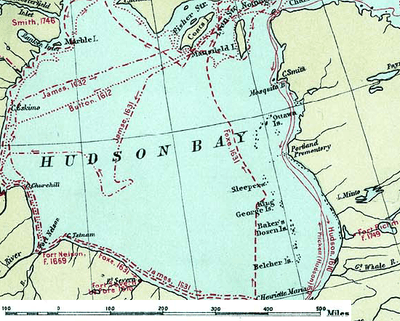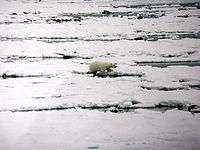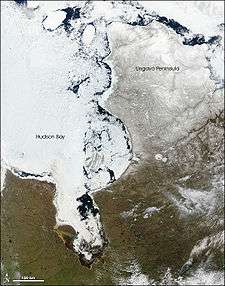Hudson Bay
| Hudson Bay | |
|---|---|
 Hudson Bay, Canada | |
| Location | North America |
| Coordinates | 60°N 085°W / 60°N 85°WCoordinates: 60°N 085°W / 60°N 85°W |
| Ocean/sea sources | North Atlantic Ocean |
| Basin countries | Canada, United States |
| Max. length | 1,370 km (851.28 mi) |
| Max. width | 1,050 km (652.44 mi) |
| Surface area | 1,230,000 km2 (470,000 sq mi) |
| Average depth | 100 metres (330 ft) |
| Frozen | mid-December to mid-June |
| Islands |
Belcher Islands, Ottawa Islands |
Hudson Bay (Inuktitut: Kangiqsualuk ilua,[1] French: baie d'Hudson), sometimes (usually historically) called Hudson's Bay, is a large body of saltwater in northeastern Canada, with a surface area of 1,230,000 square kilometres (470,000 sq mi). It drains a very large area, about 3,861,400 square kilometres (1,490,900 sq mi),[2] that includes parts of Ontario, Quebec, Saskatchewan, Alberta, most of Manitoba, southeastern Nunavut, as well as parts of North Dakota, South Dakota, Minnesota, and Montana. The southern arm of Hudson Bay is called James Bay.
The Eastern Cree name for Hudson and James Bay is Wînipekw (Southern dialect) or Wînipâkw (Northern dialect), meaning muddy or brackish water. Lake Winnipeg is similarly named by the local Cree, as is the location for the City of Winnipeg.
Description
Hudson Bay encompasses 1,230,000 square kilometres (470,000 sq mi), making it the second-largest bay in the world (after the Bay of Bengal). The bay is relatively shallow and is considered an epicontinental sea, with an average depth of about 100 metres (330 ft) (compared to 2,600 metres [8,500 ft] in the Bay of Bengal). It is about 1,370 km (850 mi) long and 1,050 km (650 mi) wide.[3] On the east it is connected with the Atlantic Ocean by Hudson Strait; on the north, with the Arctic Ocean by Foxe Basin (which is not considered part of the bay), and Fury and Hecla Strait. Geographic coordinates: 78° to 95° W, 51° to 70° N.
Hudson Bay is part of the North Atlantic Ocean.[4][5][6][7] Sometimes the Hudson Bay and Hudson Strait basins are considered part of the Arctic Ocean despite the fact that their waters flow predominantly to the Atlantic.[8] Some sources describe Hudson Bay as a marginal sea of the Atlantic Ocean,[9] or the Arctic Ocean.[10]
History

English explorers and colonists named Hudson Bay after Sir Henry Hudson, who explored the bay beginning August 2, 1610, on his ship the Discovery.[11]:170 On his fourth voyage to North America, Hudson worked his way around the west coast of Greenland and into the bay, mapping much of its eastern coast. The Discovery became trapped in the ice over the winter, and the crew survived onshore at the southern tip of James Bay. When the ice cleared in the spring, Hudson wanted to explore the rest of the area, but the crew mutinied on June 22, 1611. They left Hudson and others adrift in a small boat. No one knows the fate of Hudson and the crew members stranded with him, but historians see no evidence that they survived for long afterwards.[11]:185
In 1668, the Nonsuch reached the bay and successfully traded for beaver pelts, leading to the creation of the Hudson's Bay Company (HBC), which still bears the historic name.[12] The HBC negotiated a trading monopoly from the British crown for the Hudson Bay watershed, called Rupert's Land.[13]:4 France contested this grant by sending several military expeditions to the region, but abandoned its claim in the Treaty of Utrecht (April 1713). See Anglo-French conflicts on Hudson Bay.
During this period, the Hudson's Bay Company built several forts and trading posts along the coast at the mouth of the major rivers (such as Fort Severn, Ontario; York Factory, Manitoba; and Churchill, Manitoba). The strategic locations were bases for inland exploration. More importantly, they were used as trading posts with the indigenous peoples who came to the posts with furs from their trapping season. The HBC shipped the furs on to Europe and continued to use these posts until the beginning of the 20th century. The port of Churchill is still today an important shipping link for trade with Europe and Russia.
In 1870, when HBC's trade monopoly was abolished, it ceded Rupert's Land—an area of approximately 3.9 million km2—to Canada as part of the Northwest Territories.[13]:427 Starting in 1913, the Bay was extensively charted by the Canadian Government's CSS Acadia to develop it for navigation.[14] This mapping progress resulted in the establishment of Churchill, Manitoba, as a deep-sea port for wheat exports in 1929, after unsuccessful attempts at Port Nelson.
Due to a change in naming conventions, Hudson's Bay is now called Hudson Bay. As a result, the names of the body of water and the company are often mistaken for one another.
Geography
Extent
The International Hydrographic Organization defines the northern limit of Hudson Bay as follows:[15]
A line from Nuvuk Point (62°21′N 78°06′W / 62.350°N 78.100°W) to Leyson Point, the Southeastern extreme of Southampton Island, through the Southern and Western shores of Southampton Island to its Northern extremity, thence a line to Beach Point (66°03′N 86°06′W / 66.050°N 86.100°W) on the Mainland.
Climate

Hudson Bay was the growth centre for the main ice sheet that covered northern North America during the last Ice Age. The whole region has very low year-round average temperatures. (The average annual temperature for Churchill at 59°N is -5 °C; by comparison Arkhangelsk at 64°N in a similar cold continental position in northern Russia has an average of 2 °C.[16]) Water temperature peaks at 8°-9 °C (46°-48 °F) on the western side of the bay in late summer. It is largely frozen over from mid-December to mid-June when it usually clears from its eastern end westwards and southwards. A steady increase in regional temperatures over the last 100 years has been reflected in a lengthening of the ice-free period which was as short as four months in the late 17th century.[17]
Waters

Hudson Bay has a lower average salinity level than that of ocean water. The main causes are the low rate of evaporation (the bay is ice-covered for much of the year); the large volume of terrestrial runoff entering the bay (about 700 km3 annually; the Hudson Bay watershed covering much of Canada, and many rivers and streams discharging into the bay); and the limited connection with the Atlantic Ocean and its higher salinity. The annual freezing and thawing of sea ice, which is about three times the annual river flow into the bay, significantly alters the salinity of the surface layer.
One consequence of the lower salinity of the bay is that the freezing point of the water is higher than in the rest of the world's oceans, thus decreasing the time the bay remains ice-free.
Shores
The western shores of the bay are a lowland known as the "Hudson Bay Lowlands" which covers 324,000 km2. The area is drained by a large number of rivers and has formed a characteristic vegetation known as muskeg. Much of the landform has been shaped by the actions of glaciers and the shrinkage of the bay over long periods of time. Signs of numerous former beachfronts can be seen far inland from the current shore. A large portion of the lowlands in the province of Ontario is part of the Polar Bear Provincial Park, and a similar portion of the lowlands in Manitoba is contained in Wapusk National Park, the latter location being a significant polar bear maternity denning area.[18]
In contrast, most of the eastern shores (the Quebec portion) form the western edge of the Canadian Shield in Quebec. The area is rocky and hilly. Its vegetation is typically boreal forest, and to the north, tundra.
Measured by shoreline, Hudson Bay is the largest bay in the world (the largest in area being the Bay of Bengal).
Islands
There are many islands in Hudson Bay, mostly near the eastern coast. All are part of the territory Nunavut. One group of islands is the Belcher Islands. Another group includes the Ottawa Islands.
Geology

The Bay is near the centre of a major gravity anomaly which has been mapped in some detail by the GRACE satellites. Current theory suggests that about two-thirds of this effect is due to downwards mantle convection under the Bay area, while one-third is due to post-glacial rebound since the Laurentide ice sheet melted. Lands to the west of the Bay are rising as much as 17 millimetres (0.67 in) per year.[19]
Some geologists disagree about what created the semicircular feature, known as the Nastapoka Arc, of the bay. The overwhelming consensus is that it is an arcuate boundary of tectonic origin between the Belcher Fold Belt and undeformed basement of the Superior Craton created during the Trans-Hudson orogen.
Some geologists have argued that Hudson's Bay is possibly related to a Precambrian extraterrestrial impact and have compared it to Mare Crisium on the Moon. However, no credible evidence for such an impact crater has been found by regional magnetic, Bouguer gravity, and geologic studies.[20]
Coastal communities
The coast of Hudson Bay is extremely sparsely populated; there are only about a dozen villages. Some of these were founded as trading posts in the 17th and 18th centuries by the Hudson's Bay Company, making them some of the oldest settlements in Western Canada. With the closure of the HBC posts and stores in the second half of the 20th century, many coastal villages are now almost exclusively populated by Cree and Inuit people. Two main historic sites along the coast were York Factory and Prince of Wales Fort.
Some of the more prominent communities along the Hudson Bay coast are:
Military development
The Hudson's Bay Company built forts as fur trade strongholds against the French or other possible invaders. One example is York Factory with angled walls to help defend the fort. In the 1950s, during the Cold War, a few sites along the coast became part of the Mid-Canada Line, watching for a potential Soviet bomber attack over the North Pole. The only Arctic deep-water port in Canada is the Port of Churchill, located at Churchill, Manitoba.
Economy
Arctic Bridge

The longer periods of ice-free navigation and the reduction of Arctic Ocean ice coverage have led to Russian and Canadian interest in the potential for commercial trade routes across the Arctic and into Hudson Bay. The so-called "Arctic Bridge" would link Churchill, Manitoba, and the Russian port of Murmansk.[21]
See also
References
- ↑ Wissenladen.de
- ↑ "Canada Drainage Basins". The National Atlas of Canada, 5th edition. Natural Resources Canada. 1985. Retrieved 24 November 2010.
- ↑ Private Tutor. Infoplease.com. Retrieved on 2014-04-12.
- ↑ McColl, R.W. (2005). Encyclopedia of World Geography. Infobase Publishing. p. 57. ISBN 978-0-8160-5786-3. Retrieved 26 November 2010.
- ↑ Earle, Sylvia A.; Glover, Linda K.; National Geographic Society (2008). Ocean: An Illustrated Atlas. National Geographic Books. p. 112. ISBN 978-1-4262-0319-0. Retrieved 26 November 2010. Cite uses deprecated parameter
|coauthors=(help) - ↑ Reddy, M. P. M. (2001). Descriptive Physical Oceanography. Taylor & Francis. p. 8. ISBN 978-90-5410-706-4. Retrieved 26 November 2010.
- ↑ Day, Trevor; Garratt, Richard (2006). Oceans. Infobase Publishing. p. 21. ISBN 978-0-8160-5327-8. Retrieved 26 November 2010.
- ↑ Lewis, Edward Lyn; Jones, E. Peter; North Atlantic Treaty Organization. Scientific Affairs Division (2000). The Freshwater Budget of the Arctic Ocean. Springer. pp. 101, 282–283. ISBN 978-0-7923-6439-9. Retrieved 26 November 2010. Cite uses deprecated parameter
|coauthors=(help) - ↑ Peter Calow (12 July 1999). Blackwell's concise encyclopedia of environmental management. Wiley-Blackwell. p. 7. ISBN 978-0-632-04951-6. Retrieved 29 November 2010.
- ↑ John Wright (30 November 2001). The New York Times Almanac 2002. Psychology Press. p. 459. ISBN 978-1-57958-348-4. Retrieved 29 November 2010.
- 1 2 Butts, Edward (2009-12-31). Henry Hudson: New World voyager. Dundurn Press Ltd. p. 170. ISBN 978-1-55488-455-1. Retrieved 1 August 2011.
- ↑ "Nonsuch Gallery". Manitoba Museum. Retrieved 1 August 2011.
- 1 2 Galbraith, John S. (1957). The Hudson's Bay Company. University of California Press.
- ↑ "CSS Acadia". Maritime Museum of the Atlantic. Retrieved 1 August 2011.
- ↑ "Limits of Oceans and Seas, 3rd edition" (PDF). International Hydrographic Organization. 1953. Retrieved 6 February 2010.
- ↑ GHCN climatic monthly data, GISS, using 1995–2007 annual averages
- ↑ General Survey of World Climatology, Landsberg ed., (1984), Elsevier.
- ↑ C. Michael Hogan (2008) Polar Bear: Ursus maritimus, globalTwitcher.com, ed. Nicklas Stromberg
- ↑ Silverman, Jacob. "How can parts of Canada be 'missing' gravity?". HowStuffWorks. Retrieved 24 March 2012.
- ↑ Eaton D. W. and F. Darbyshire, 2010, Lithospheric architecture and tectonic evolution of the Hudson Bay region. Tectonophysics. v. 480, pp. 1–22.
- ↑ "Russian ship crosses 'Arctic bridge' to Manitoba". The Globe and Mail (Toronto). 18 October 2007.
- Atlas of Canada, online version.
- Some references of geological/impact structure interest include:
- Rondot, Jehan (1994). Recognition of eroded astroblemes. Earth-Science Reviews 35, 4, p. 331-365.
- Wilson, J. Tuzo (1968) Comparison of the Hudson Bay arc with some other features. In: Science, History and Hudson Bay, v. 2. Beals, C. S. (editor), p. 1015–1033.
| Wikimedia Commons has media related to Hudson Bay. |
| Wikisource has the text of the 1911 Encyclopædia Britannica article Hudson Bay. |
| ||||||||||||||
|